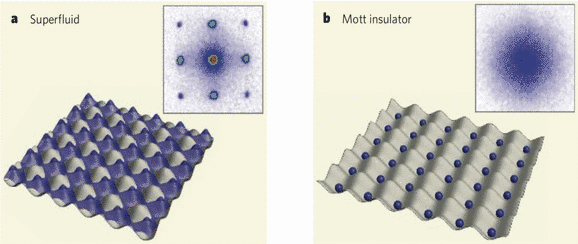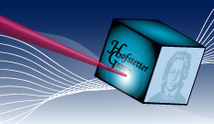Optical lattices
In 1995, when Bose-Einstein condensation (BEC) in an alkali gas of Rubidium was achieved, one could wonder whether confirmation of an uncontroversial prediction was really worth it. The BEC achievement was accompanied with some extraordinary experiemntal techniques which were perhaps more interesting than BEC itself.These new tools paved a way toward a tremendous advance in experimental atomic physics and quantum optics.
Among these techniques, one of the most exciting one is optical lattice, an artificial crystal made of light (for a general review see e.g [1]). These artificial lattices work as follows: when atoms are exposed to a pair of counter propagating laser fields which are not resonant with an atomic optical transition (and thus does not excite the atomic electrons), they experience a periodic potential. This potential originates from the interaction between an induced dipole moment in an atom and an external electric field provided by laser beams. This periodic potential can be written in the form [2]

where k=2π/λ is the wave vector of the laser light used to form the optical standing wave and V0 the lattice potential depth.The natural energy scale for this depth is the recoil energy ER=ℏ2k2/2m (m being the mass of a single neutral atom).
Based on this general idea, today one can rountinly make optical lattices, change their dimensions and adjust geometries, maniluplate the lattice to provide atoms be in different interaction regiems, creates disorder in a controlled way and investigate time-dependent many-body systems [3]. Ultracold atoms in this type of laser-made lattice play the part of electrons in a solid; they tunnel quantum-mechanically between lattice sites just as sinlge or paired electrons (Cooper pairs) tunnel through the periodic potential wells. The atoms in such a lattice mimic the rich dynamics of a many-body interacting system as one encounter in conventional condensed matter physics in a real crystalline material. Optical lattices thus implement Richard Feynman's pioniring idea of quantum simulation i.e using one quantum system to simulate another one [4].
Different interaction regiems is a crucial issue in manipulating cold-atoms in order to get diverse phases. Strongly interacting systems have particular interest in many physical system, specially it is commonly believed that strong correlations are relevant for some of the most fundamental open questions in condensed matter e.g high-Tc [5] and quantum magnetism [6]. As the first tool to achieve the strong coupling regime, Feshbash resonance was successfully applied to a gas. It is based on changing the two-particle scatering lenght by tuning an external magnetic field. This extremely powerful 'knob' enabled to not only change the strength of the inter-particle interaction but also its sign, from attractive to repulsive. However in optical lattices the strong correlation regime is obtained in a different way. The idea is not to increase atom-atom interaction strength, but rather to decrease all other single-particle energy such as the kinetic energy of the atoms, such that interaction between atoms dominate the dynamics.
More rigorously, the interacting atoms (considering now Bosons) in an optical lattice can be well-described by the (single-band) Bose-Hubbard Hamiltonian

The first term in this Hamiltonian is the kinetic energy of a single atom. It is characterized by hopping amplitude J between neighboring sites i,j. The operators ai creat and destroy a particle on site i. The second term describes the on-site interaction U between atoms when they have ni. This is a local interaction term i.e. the atoms intearct only when they occupy the same site. This is indeed justifiable for cold-atoms as their interaction is very short-range. Therefore there are two distincts energy scales that governs the model.
For weak interaction relative to kinetic, U/J<<1, the system is in superfluid state i.e. all atoms can hop easily and they become delocalized over the whole lattice. In this state the atoms have a large phase coherence; if the gas is released by abruptly switching off the lattice the long range phase coherence shows up as peaks in the interference pattern. On the other hand, if interaction energy dominates over the kinetic energy, U/J>>1, the atoms tend to localize and hopping probability decreases largely. If the gas will be released now from the lattice, there is no coherence peak. The phase transition between these two regimes is a quantum phase transition as it takes place at zero temperature and it is driven solely by change in parameter of Hamiltonian. By tuning the ratio between interaction energy and kinetic energy U/J, Markus Greiner and co-workers in a seminal experiment [7] succeeded to observe this quantum phase transition between Mott insulator and superfluid regimes in a Bosonic gas.

Two distinct phases for Bosonic gases in an optical lattice. a superfluid state with movable atoms over the lattice and interfrence pattern (inset). b a Mott insulator phase with localized atoms in every lattice site. Picture from Ref.[4].
After succesful engineering of optical lattices, some other important phenomena have been also observed in optical lattices. To date we can (partially) name observing Fermi surface [8], Fermionic Mott insulator [9,10], superexchange coupling for Boson [11], Fermionic superfluidity in optical lattices [12], collapse and revival of a BEC in an optical lattice [13] , Bose-Fermi mixture in optical lattices [14], Anderson localization in a random potential [15].
[1] I. Bloch, Nature Physics 1, 23 (2005)
[2] W. Hofstetter, Phil. Mag. 86, 1891 (2006)
[3] I. Bloch, J. Dalibard and W. Zwerger, Rev. Mod. Phys. 80, 885 (2008)
[4] M. Greiner and S. Fölling, Nature 453, 736 (2008)
[5] A.J. Leggett, Nature Physics 2, 134 (2006)
[6] S. Sachdev, Nature Physics 4, 173 (2008)
[7] M. Greiner et.al., Nature 415, 39 (2002)
[8] M. Köhl et.al., Phys. Rev. Lett. 94, 080403 (2005)
[9] J. Jördens et.al., Nature 455, 204 (2008)
[10] U. Schneider et.al, Science 322, 1520 (2008)
[11] S. Trotzky et.al. Science 319, 295 (2008)
[12] J.K. Chin et.al., Nature, 443, 961 (2006)
[13] M. Greiner et.al., Nature, 419, 51 (2002)
[14] Th. Best et.al., Phys. Rev. Lett. 102, 030408 (2009)
[15] G. Roati et.al., Nature 453, 895 (2008)





